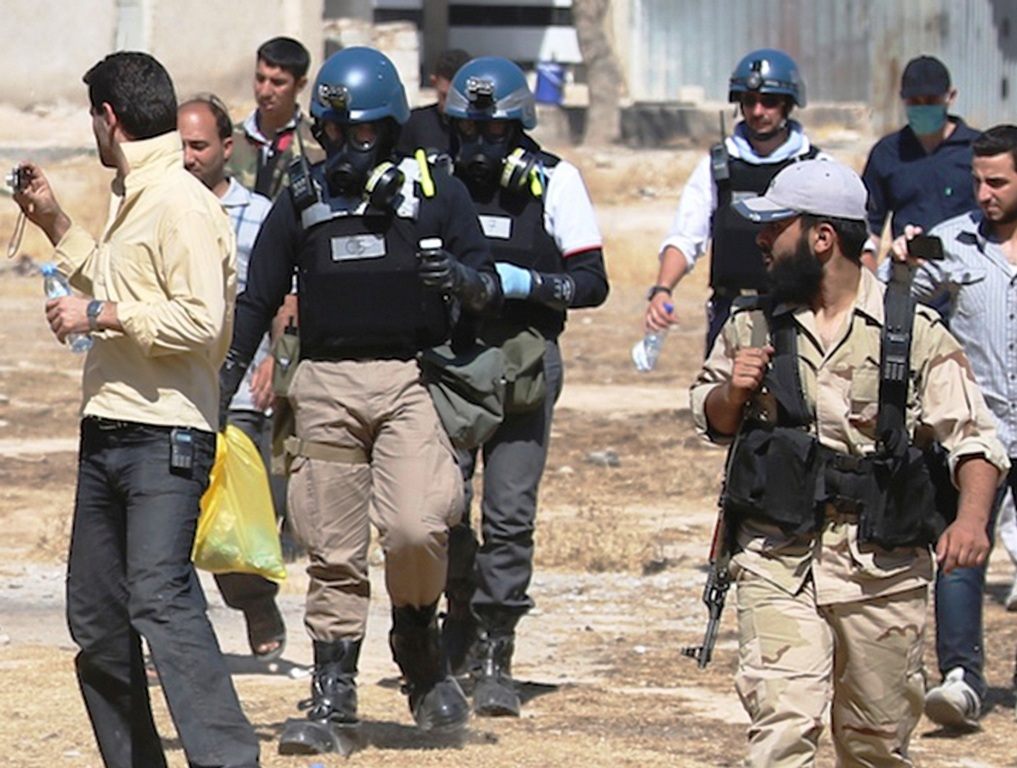Australia/Israel Review
Scribblings: Defective Inspection
Oct 9, 2017 | Tzvi Fleischer

Tzvi Fleischer
As noted elsewhere in this magazine, on September 7, Israeli warplanes allegedly attacked what is thought to have been a Syrian regime chemical weapons and missile research facility near the city of Hama.
Israel has apparently struck many targets in Syria over the past few years as part of its quest to stop the transfer of advanced weapons to the Lebanese terror group Hezbollah. What was notable about this one is that Syria is not supposed to have such facilities at all.
In 2013, the US made a deal with Russia for Syria to eliminate all its chemical weapons stocks and facilities. By 2014, inspectors from the Organisation for the Prohibition of Chemical Weapons (OCPW) were to have ensured everything was destroyed or dismantled.
However, today, everyone knows this process was far from 100% effective. Not only has the Syrian regime repeatedly used chlorine gas against enemy civilians, in April it employed sarin gas against the town of Khan Sheikhoun, as confirmed by experts associated with the UN.
So why did the inspection regime for Syria’s chemical weapons fail?
Reuters published an article on August 17 which goes some way to explaining this – based on “half a dozen interviews with officials, diplomats, and investigators involved in eliminating Syria’s weapons of mass destruction.” Inspectors said that they believed from the first that the information provided by the Syrians on their chemical weapons was inaccurate and inconsistent with what they saw on the ground. Moreover, the Syrians succeeded in hampering the inspection process through tactics including “withholding visas, submitting large volumes of documents multiple times to bog down the process, last-minute restrictions on site inspections and coercing certain witnesses to change their stories.”
Furthermore, Syrian efforts to hamper inspection have been so effective that inspectors effectively stopped trying, with the article reporting, “The OPCW team has carried out 18 site visits since 2013, but has now effectively given up because Syria has failed to provide sufficient or accurate information.”
In addition, inspectors failed to report the regime’s interference with their inspections in order to maintain the relationship they need with the Assad regime: “The extent of Syria’s reluctance to abandon chemical weapons has not previously been made public for fear of damaging international inspectors’ relationship with Assad’s administration and its backer, Russia,” the story reported.
These revelations from Reuters are actually not completely new – they are very similar to reporting done by the Wall Street Journal two years ago (July 23, 2015) which found that the “Syrian regime controlled where inspectors went, what they saw and, in turn, what they accomplished.” Furthermore, the right under the agreement for Western governments to demand inspectors be given access to undeclared weapons sites where there was “evidence they were part of the chemical-weapons program” were never exercised, because, according to inspectors and Western officials, “their governments didn’t want a standoff with the regime.”
But these problems with ridding a rogue regime of its illegal weapons via a system of agreed international inspections are not just applicable to Syria. It is also a lesson for Iran and its nuclear program.
There is persuasive evidence inspection of Iran by the International Atomic Energy Agency under the 2015 nuclear agreement with Iran may be going down a similar path:
• Firstly, we know that the IAEA inspectors are not getting access to Iranian military sites and the Iranians are swearing they will never allow such access. Yet following the agreement on the nuclear deal in 2015, then US Secretary of State John Kerry, who negotiated the deal, said that Iranian refusal to allow inspections of military sites would constitute a “material breach of this agreement.”
• In particular, inspectors have never been able to physically examine the Parchin military site – long suspected as being a major site of nuclear explosives research – they can only conduct limited video monitoring and use soil samples taken by the Iranians themselves. Yet in 2016, the IAEA found uranium particles near Parchin that the Obama Administration admitted were likely tied to the regime’s nuclear weapons program.
• According to Haaretz (Sept. 17), Israeli officials say that, just after the nuclear deal was implemented in early 2016, a Western nation gave the IAEA a list of undeclared Iranian sites suspected of being part of the nuclear program. Almost none of these were subsequently inspected by the IAEA, and the small number of actual visits occurred after a long Iranian refusal, providing ample time to clean them up. Other inspection requests were declined by Iran on the grounds they were “military sites.” An Israeli official was quoted as saying, “There is a whole list of suspicious sites where the Iranians do not allow inspectors to visit and no one enforces the supervision mechanisms established in the nuclear agreement… The sense is that Iran allows what it wants, and does not allow what it does not want.”
• IAEA reports on Iran’s nuclear program have become much less informative since the deal was signed, no longer including key data such as centrifuge production, centrifuge R&D activities, the exact quantity of heavy water Iran has stored in Oman, and nuclear weaponisation issues.
• Furthermore, IAEA inspections in Iran have actually declined in intensity since the deal came into effect. According to numbers collected by former senior IAEA inspector Olli Heinonen, in 2015, inspectors spent 2,170 work days on inspections in Iran. In 2016, after implementation of the deal, this declined to 1,042.
The Iran nuclear deal relies heavily on IAEA inspections for verification. Given how much the above sounds like the inspection failure in Syria, there are very good reasons to doubt they are up to the job.
Tags: International Security, Iran, JCPOA






